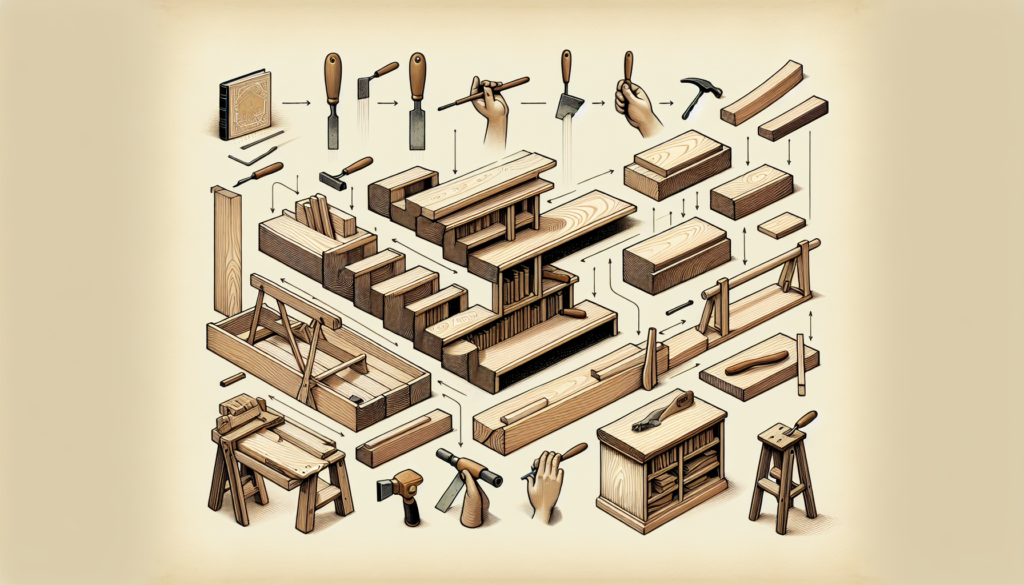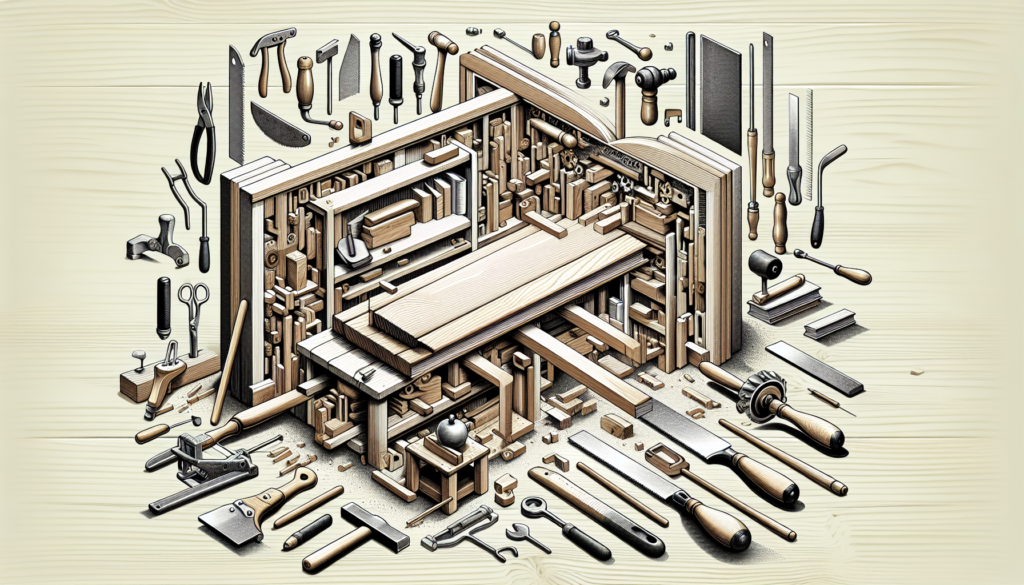Have you ever wondered if it’s possible to build a bookcase without using any power tools? Well, you’re in for a delightful surprise! In this article, we will explore the fascinating world of DIY bookcase construction, uncovering the secrets to creating a beautiful piece of furniture with nothing but your own two hands and a few hand tools. So, roll up your sleeves and let’s dive into the incredible journey of crafting a bookcase that will not only elevate your home decor but also ignite a sense of accomplishment within you.

Choosing the Right Material
When it comes to building a bookcase, one of the first things you need to consider is the material you will use. Wood is a popular choice due to its durability and natural beauty. There are various options available, each with its own characteristics.
Wood Options
There are several types of wood to choose from, and each has its own advantages and disadvantages. Oak is a popular choice for its strength and durability, while pine offers a more affordable option with a lighter appearance. If you prefer a more exotic look, you might consider using mahogany or cherry wood. It’s important to consider both the aesthetic appeal and the practicality of the wood when making your decision.
Other Materials
While wood is a classic choice for building a bookcase, it’s not the only option. If you’re looking for a more modern or industrial look, you might consider using metal or glass. These materials can add a unique touch to your bookcase and create a visually striking piece. However, keep in mind that working with these materials may require different tools and techniques compared to working with wood.
Essential Tools
To build a bookcase, you’ll need a few essential tools. While power tools can make the process faster and more efficient, it is indeed possible to build a simple bookcase without them. Here are the essential tools you’ll need:
Measuring Tools
Accurate measurements are crucial when building a bookcase. A measuring tape and a combination square are essential tools for ensuring precise measurements. These tools will help you determine the dimensions of the bookcase and the sizes of the individual components.
Cutting Tools
To cut the wood or other materials, you’ll need a selection of cutting tools. A hand saw is a versatile tool that can be used to make straight cuts. A backsaw with a miter box will help you achieve accurate angled cuts. Additionally, a coping saw can be useful for intricate cuts or curved designs.
Joinery Tools
Joinery tools are used to connect the different pieces of the bookcase. A chisel will help you create recesses for various joinery methods. A mallet is also useful for driving chisels or assembling joints. Additionally, a hand plane can be used to smooth and flatten surfaces for a more professional finish.
Assembly Tools
When it’s time to assemble the bookcase, you’ll need some tools to hold the pieces together. A screwdriver or drill with screwdriver bits will be necessary if you choose to use screws for assembly. Clamps are also essential for securing the joints and ensuring a tight fit.
Finishing Tools
To give your bookcase a polished look, you’ll need a few finishing tools. Sandpaper is essential for smoothing surfaces and removing any imperfections. A paintbrush or foam applicator can be used to apply stain or paint, while a soft cloth is useful for buffing and applying a protective finish.
Planning and Design
Before you start building your bookcase, it’s important to spend some time planning and designing it. This will ensure that you have a clear vision of the finished product and help you avoid any mistakes during construction.
Determining Measurements
The first step in planning your bookcase is to determine the measurements. Consider the available space in your home and the intended use of the bookcase. Measure the height, width, and depth of the area where the bookcase will be placed. It’s also important to decide how many shelves you want and the spacing between them. Taking accurate measurements will help you create a bookcase that fits perfectly in its intended location.
Sketching the Design
Once you have the measurements, it’s time to sketch out your design. This doesn’t have to be a work of art; a simple rough sketch will suffice. Include details such as the overall dimensions, the number of shelves, and any decorative elements you want to incorporate. Sketching the design will give you a visual representation of your bookcase and allow you to make any necessary adjustments before you start cutting the materials.
Creating a Material List
With the design in hand, you can now create a material list. Take into account the type of wood or material you have chosen, as well as the required dimensions for each component. Calculate the number of boards or sheets you’ll need and add a little extra to account for any mistakes or changes in the design. Having a comprehensive material list will ensure you have everything you need before you begin construction.
Preparing the Materials
With the planning and design phases complete, it’s time to start preparing the materials for your bookcase. Proper preparation ensures that the pieces fit together accurately and creates a solid foundation for your project.
Measuring and Marking
Once you have your material list, begin by measuring and marking the components according to the dimensions specified in your design. Use a measuring tape, combination square, and a pencil to ensure accurate markings. Take your time with this step, as precise measurements and markings will save you time and frustration later in the process.
Cutting the Pieces
With the measurements and markings in place, it’s time to cut the pieces for your bookcase. Use the appropriate cutting tools mentioned earlier to make straight cuts, angled cuts, or any other specialized cuts required for your design. Take care to follow your measurements and markings accurately to ensure that all the pieces fit together seamlessly.
Sanding and Smoothing
After cutting the pieces, it’s essential to sand and smooth the surfaces. Use sandpaper or a hand plane to remove any rough edges, splinters, or imperfections. Focus on the edges and faces of the components that will be visible once the bookcase is assembled. Sanding and smoothing the pieces will not only improve their appearance but also make assembly easier and safer.

Making Basic Joints
To assemble your bookcase, you’ll need to create joints that securely connect the various pieces together. While there are many types of joints to choose from, let’s focus on the three basic ones: butt joints, miter joints, and dado joints.
Butt Joints
Butt joints are the simplest type of joint and involve joining two pieces of wood by simply butting them together. To strengthen the joint, you can use dowels, screws, or nails. It’s important to ensure that the surfaces are flush and that the joint is securely held together.
Miter Joints
Miter joints are commonly used for creating clean, seamless corners in furniture. To create a miter joint, the ends of the pieces are cut at a 45-degree angle so that they fit together neatly. Glue or splines are typically used to reinforce the joint and ensure its stability.
Dado Joints
Dado joints are used to create strong connections between horizontal and vertical pieces. A dado is a groove or channel cut into one piece of wood, into which the other piece fits. This creates a secure joint that prevents the pieces from shifting. Dado joints can be created using a chisel or a dado blade on a table saw.
Assembling the Bookcase
Now that you have cut the pieces and created the necessary joints, you’re ready to assemble your bookcase. The assembly process involves putting all the pieces together to create the framework of the bookcase.
Dry Fitting the Parts
Before permanently joining the pieces, it’s important to do a dry fit. This involves temporarily assembling the components without any glue or fasteners to ensure everything fits together correctly. This step allows you to make any necessary adjustments or corrections before moving on to the next stage.
Gluing and Clamping
Once you’re satisfied with the dry fit, it’s time to glue and clamp the pieces together. Apply wood glue to the joints and carefully assemble the components. Use clamps to hold the joints tightly together while the glue dries. The number and placement of clamps will depend on the size and design of your bookcase.
Adding Reinforcements
To ensure the strength and stability of your bookcase, consider adding reinforcements. These can include screws, nails, or dowels. Reinforcements help prevent the joints from separating and increase the overall durability of the bookcase. Carefully consider the placement and size of the reinforcements to ensure they are effective without compromising the aesthetic appeal of the piece.

Finishing Touches
Once the bookcase is assembled, it’s time to give it the finishing touches. These steps will enhance the appearance and protect the wood or other materials from damage.
Sanding the Entire Piece
Before applying any finish, sand the entire bookcase to create a smooth and even surface. Start with a coarse-grit sandpaper to remove any imperfections, then progress to finer grits to achieve a polished finish. Be sure to sand with the grain of the wood to avoid scratches or uneven spots.
Applying Stain or Paint
If you want to change the color or enhance the natural beauty of the wood, consider applying stain or paint. Stain penetrates the wood, bringing out its grain and adding depth to the piece. Paint, on the other hand, provides a solid color and can be a great way to add a personal touch. Use a paintbrush or foam applicator to apply the stain or paint evenly, following the manufacturer’s instructions.
Adding Protective Finish
To protect your bookcase from daily wear and tear, it’s important to apply a protective finish. This can be in the form of varnish, polyurethane, or wax. The finish will seal the wood, making it resistant to spills, scratches, and fading. Apply the protective finish using a brush or cloth according to the product’s instructions. Multiple coats may be required for optimal protection and longevity.
Alternative Joinery Methods
While we discussed basic joinery methods earlier, there are other options available if you want to explore alternative techniques:
Pocket Hole Joinery
Pocket hole joinery involves using a special jig to create angled holes in the wood. Screws are then inserted into these holes to create strong and hidden joints. This method is popular for its simplicity and efficiency, as it eliminates the need for complex joinery techniques.
Dowel Joinery
Dowel joinery involves using wooden dowels to join the pieces together. Holes are drilled into the wood, and dowels are inserted, creating a secure connection. Dowel joinery is strong and visually appealing, as the dowels can be left exposed or covered with wood plugs.
Biscuit Joinery
Biscuit joinery utilizes small, football-shaped wooden pieces called biscuits that are placed in matching slots in the wood. The biscuits are then glued, and the pieces are clamped together. This method offers good alignment and stability, especially for edge-to-edge joints or miter joints.

Considering Safety Measures
When working on any woodworking project, safety should be your top priority. Here are a few safety measures to consider:
Protective Gear
Always wear appropriate protective gear, such as safety glasses, ear protection, and a dust mask. This will help protect your eyes, ears, and respiratory system from dust, debris, and noise. Additionally, wearing gloves can help prevent injuries from sharp tools and splinters.
Safe Handling of Tools
Make sure you know how to safely handle and operate your tools. Follow the manufacturer’s instructions and use the appropriate techniques. Keep cutting tools sharp to prevent accidents caused by dull blades. It’s also important to store your tools properly and out of reach of children.
Workspace Arrangement
Create a well-organized and uncluttered workspace to minimize the risk of accidents. Clear the area of any obstacles or tripping hazards, and ensure good lighting. Maintain a clean workspace to prevent trips and falls and to keep your tools and materials easily accessible.
Troubleshooting Tips
Even with careful planning and execution, issues may arise during the construction process. Here are a few troubleshooting tips to help you address common problems:
Correcting Measurement Errors
If you make a measurement error, don’t panic. Assess the situation and determine if a slight modification can be made to the affected piece. In some cases, you may need to recut a piece, but don’t let this discourage you. Take your time, double-check your measurements, and make the necessary adjustments before proceeding.
Fixing Loose Joints
If you find that a joint is loose or not as tight as desired, you have a few options. You can disassemble the joint, clean off the glue, and add more adhesive before reassembling. If the joint is already glued and clamped, you can carefully tap it with a mallet to close any gaps. If necessary, use cauls or additional clamps to apply pressure and ensure a tight joint.
Repairing Chips or Scratches
Accidents happen, and sometimes you may end up with chips or scratches on your bookcase. Fortunately, these can usually be repaired. For small chips, you can fill them with wood filler or putty. Once dry, sand the area and refinish it to match the surrounding wood. For deeper scratches or gouges, you may need to use a technique called wood patching, which involves filling the damaged area with a mixture of sawdust and glue.
Building a bookcase without power tools may take a bit more time and effort, but it’s entirely possible. By following the steps outlined in this article and utilizing the right tools and techniques, you can create a beautiful and functional bookcase that will proudly display your personal library. So grab your tools, unleash your creativity, and enjoy the satisfaction of building something with your own two hands. Happy woodworking!


